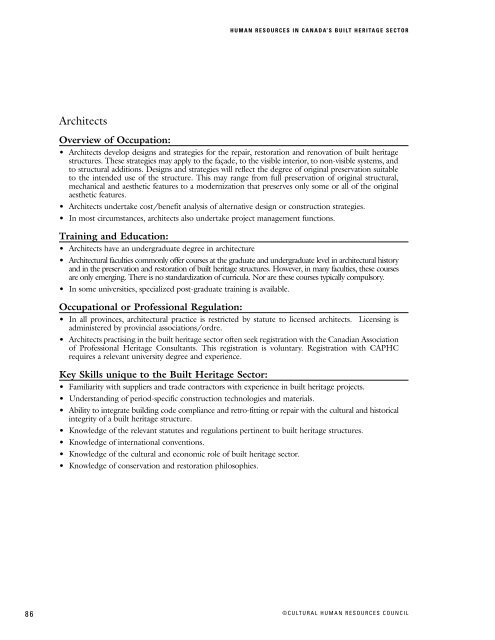Human Resources in Canada's Built Heritage Sector: Mapping the ...
Human Resources in Canada's Built Heritage Sector: Mapping the ...
Human Resources in Canada's Built Heritage Sector: Mapping the ...
- No tags were found...
Create successful ePaper yourself
Turn your PDF publications into a flip-book with our unique Google optimized e-Paper software.
HUMAN RESOURCES IN CANADA’S BUILT HERITAGE SECTORArchitectsOverview of Occupation:• Architects develop designs and strategies for <strong>the</strong> repair, restoration and renovation of built heritagestructures. These strategies may apply to <strong>the</strong> façade, to <strong>the</strong> visible <strong>in</strong>terior, to non-visible systems, andto structural additions. Designs and strategies will reflect <strong>the</strong> degree of orig<strong>in</strong>al preservation suitableto <strong>the</strong> <strong>in</strong>tended use of <strong>the</strong> structure. This may range from full preservation of orig<strong>in</strong>al structural,mechanical and aes<strong>the</strong>tic features to a modernization that preserves only some or all of <strong>the</strong> orig<strong>in</strong>alaes<strong>the</strong>tic features.• Architects undertake cost/benefit analysis of alternative design or construction strategies.• In most circumstances, architects also undertake project management functions.Tra<strong>in</strong><strong>in</strong>g and Education:• Architects have an undergraduate degree <strong>in</strong> architecture• Architectural faculties commonly offer courses at <strong>the</strong> graduate and undergraduate level <strong>in</strong> architectural historyand <strong>in</strong> <strong>the</strong> preservation and restoration of built heritage structures. However, <strong>in</strong> many faculties, <strong>the</strong>se coursesare only emerg<strong>in</strong>g. There is no standardization of curricula. Nor are <strong>the</strong>se courses typically compulsory.• In some universities, specialized post-graduate tra<strong>in</strong><strong>in</strong>g is available.Occupational or Professional Regulation:• In all prov<strong>in</strong>ces, architectural practice is restricted by statute to licensed architects. Licens<strong>in</strong>g isadm<strong>in</strong>istered by prov<strong>in</strong>cial associations/ordre.• Architects practis<strong>in</strong>g <strong>in</strong> <strong>the</strong> built heritage sector often seek registration with <strong>the</strong> Canadian Associationof Professional <strong>Heritage</strong> Consultants. This registration is voluntary. Registration with CAPHCrequires a relevant university degree and experience.Key Skills unique to <strong>the</strong> <strong>Built</strong> <strong>Heritage</strong> <strong>Sector</strong>:• Familiarity with suppliers and trade contractors with experience <strong>in</strong> built heritage projects.• Understand<strong>in</strong>g of period-specific construction technologies and materials.• Ability to <strong>in</strong>tegrate build<strong>in</strong>g code compliance and retro-fitt<strong>in</strong>g or repair with <strong>the</strong> cultural and historical<strong>in</strong>tegrity of a built heritage structure.• Knowledge of <strong>the</strong> relevant statutes and regulations pert<strong>in</strong>ent to built heritage structures.• Knowledge of <strong>in</strong>ternational conventions.• Knowledge of <strong>the</strong> cultural and economic role of built heritage sector.• Knowledge of conservation and restoration philosophies.86©CULTURAL HUMAN RESOURCES COUNCIL










